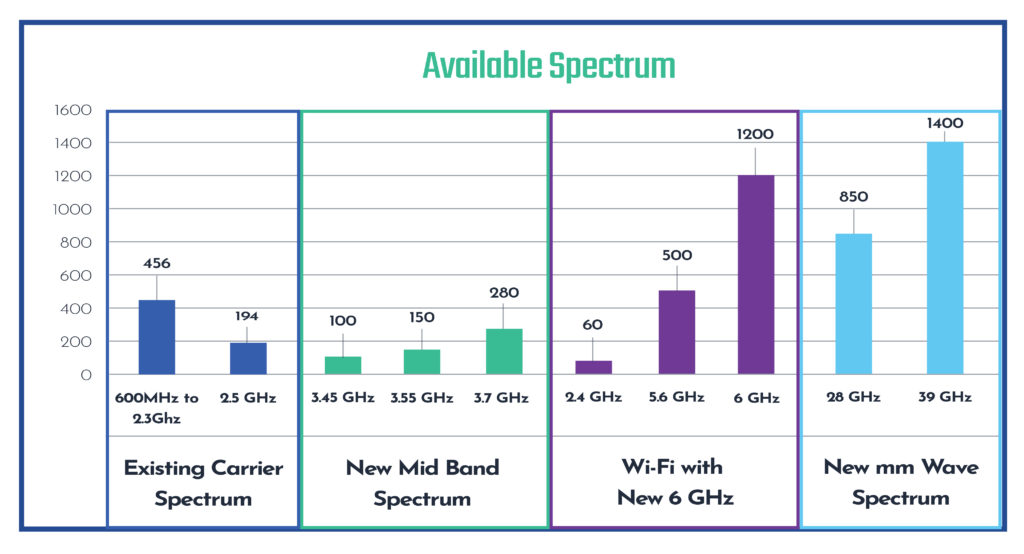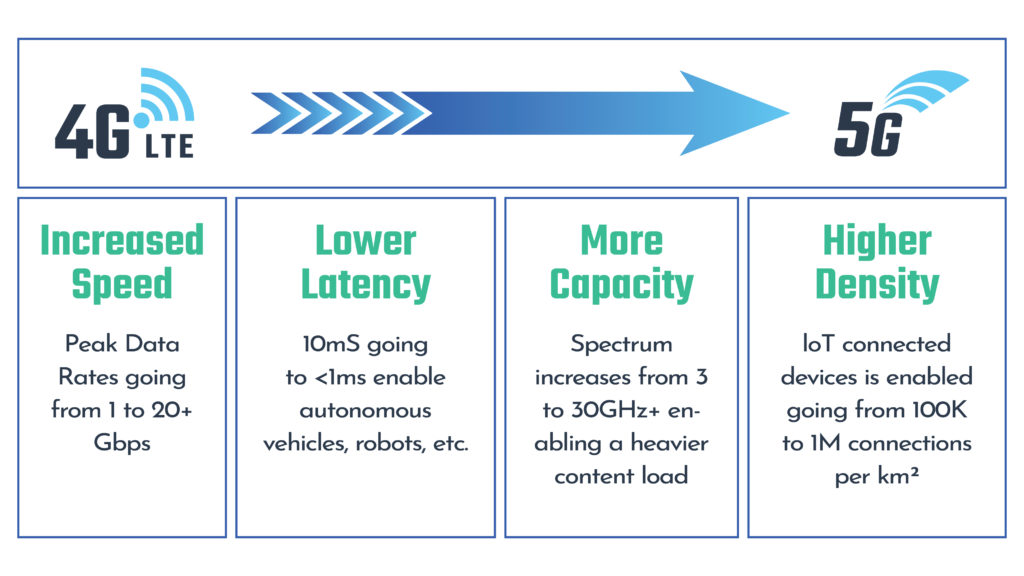August 30, 2021

Download the Ultimate Guide to Digital Transformation in a Wireless World in eBook form
Learn how to implement digital transformation for your property in smart ways, including key considerations and practical advice for your wireless infrastructure.
Why Digital Transformation? Why Now?
It is incredible – the amount of radical change in the wireless communications industry today is astounding. All at once, the industry welcomed 5G, Wi-Fi 6, and Private Networking/CBRS, as well as quite a bit of new spectrum from C Band and mmWave. The combination of new technologies and more spectrum offers unprecedented speeds and capacity that players from every corner are racing to exploit. Add novel applications on top of this capability, and the result is transformative opportunities that change how businesses function and how people live their lives.
While this is exciting, it can be hard for decision-makers to understand and keep up with such dramatic change. The change creates opportunities for tech leaders, property owners, managers, and developers to make incredible impacts for their businesses and communities, but it also increases the risk of making mistakes. (Nobody wants to invest millions of dollars in a solution that fails to live up to its potential or in technology that has to be ripped and replaced a few years down the road).
This blog will serve as a comprehensive guide for understanding the role that wireless connectivity plays in organizational digital transformation and provide a practical framework for how to “go big” (in smart ways), avoid missteps, and take full advantage of the opportunities ahead.
How to Drive Digital Transformation
We firmly believe that the key to successful digital transformation for any organization is to take incremental steps forward to test and learn and get up to speed in three key areas: spectrum, 5G technology, and applications.
In this post, business and property owners will learn:
- Spectrum – What bandwidth is available today? What is coming tomorrow? What solutions can new spectrum enable?
- 5G Technology – What is 5G? What about 5G will help achieve organizational goals? Why is 5G significant for digital transformation?
- Wi-Fi 6 and Wi-Fi 6e – What is changing and how can you benefit from it?
- CBRS and Private Networking – What is CBRS? How are different verticals deploying CBRS today using different applications and use cases?
- Applications – What solutions are successfully being deployed? How to identify the most compelling use cases for your organization.
- Four key considerations that can help businesses deploy transformational wireless applications successfully
The Role of Spectrum in Digital Transformation

The Challenge:
Traditionally, organizations have been spectrum-limited; AT&T, T-Mobile, and Verizon owned a combined total of 650 MHZ, of which Verizon owned 115 MHz. This limited amount has become an issue as applications like video streaming, video conferencing, and enhanced reality have increased capacity needs. In fact, the increased need is expected to continue at an annual CAGR of 27%. To put this growth in perspective, total data usage in North America is projected to grow from 12 exabytes (EB) in 2021 to 49EB in 2026. If we as an industry don’t respond accordingly, our applications will perform like cars driving 70 miles an hour down a bumpy old dirt road.
The Solution:
The FCC is increasing spectrum availability by adding new frequencies for the carriers to purchase. It is analogous to what Eisenhower did in the 50s when he built out the interstate highway system to increase capacity for automobiles. Similarly, the FCC is more than doubling capacity by adding new frequencies (lanes) so that capacity-hungry applications (cars) can operate at higher speeds with greater efficiency. Like the interstate highway system, this added spectrum will change how the country moves and operates.
The FCC has focused most of its attention on releasing what is called the “Mid Band” of spectrum. In the last 12 months alone, over 430 MHz of new spectrum was introduced into the market — 150MHz at 3.5GHz (CBRS) and 280MHz at 3.7GHz (C Band). To give you an idea of how valuable this capacity is, the carriers invested over $80 billion in the new C Band spectrum alone.
In addition to the Mid Band, the FCC also introduced mmWave at 28GHz and 39GHz; the mmWave release potentially quadruples the spectrum available for use by carriers going forward. Here is a quick picture of the overall spectrum landscape:

Preparing for the Future
Making choices about how best to prepare for the new spectrum may seem daunting, but it is relatively straightforward to establish a solution that can support growing changing requirements. My seasoned team at Connectively Wireless recommends the following solution-building approach:
- Begin with limited frequency support to keep initial costs down. All three carriers (AT&T, T-Mobile and Verizon) support 1900 and 2100MHz frequencies, so this is a great baseline starting point.
- Invest in a system that can evolve. Specifically, make sure the system can evolve to support the Mid Band spectrum, which is likely where industry attention in 5G will grow.
- Phase in new frequency support over time:
- Add 2.5GHz – T-Mobile obtained this spectrum as part of the Sprint merger; they own 194MHz of the 2.5GHz frequency. Many in-building systems struggle to cover all of the 194MHz spectrum, so there are two things to consider. First, make sure the in-building system can add the 2.5GHz spectrum effectively. Second, make sure the system can support all 194MHz; T-Mobile will likely require this before investing in in-building wireless systems.
- Add 3.7GHz (C-Band) – A variety of carriers recently purchased new spectrum in the C Band auction, which included 280MHz of new spectrum. Verizon was a big winner, more than doubling its spectrum holdings. Much like the previous 2.5GHz considerations, make sure you are not caught in a rip-and-replace situation because the in-building system does not support 3.7GHz or cannot support all of the C Band frequency.
- Add 3.5 GHz (CBRS) – The 3.55GHz spectrum is also called CBRS, OnGo, private LTE and private networking. For simplicity, we will refer to 3.55GHz as CBRS. CBRS is a very different spectrum offering because it is not owned by the carriers. Of the 150MHz of available spectrum, 80MHz is free for public use and the other 70MHz was auctioned off for priority use on a county-by-county basis by the FCC to any market investor, including private enterprises, cable companies and traditional carriers. Any organization can deploy a private network on the 80MHz of free spectrum, making it a key component to be planned for in any in-building system. Deployed systems will also need the flexibility to support all 150MHz.
4. Check your passives infrastructure. Antennas, couplers, and combiners that are used when deploying an in-building wireless system often get overlooked. System integrators sometimes deploy cheap versions of passive components to keep costs down or to compete for RFPs. Inferior passives, however, can cause serious issues down the road. Many cheap components only cover up to 2.5GHz and need to be replaced when it’s time to add new spectrum. Their replacement is tough; they are often located in ceilings and require significant construction, patch, and paint. It is worth the upfront investment to install components that can cover 600MHz to 6GHz.
A Note About Business Models: Understand that business models are likely to change over time as new frequencies and 5G are introduced. Most organizations have traditionally been used to working with AT&T, T-Mobile and Verizon. While this will likely continue to be the focus, building owners can now own and deploy their own networks on CBRS, and new entrants that purchase spectrum are expected to offer connectivity in buildings including cable companies, technology titans and local wireless players.
How 5G Technology is Driving Digital Transformation

5G means different things to different people. In general, 5G represents an evolution from 4G LTE (Long Term Evolution) to 5G NR (New Radio) technology. Much of the 5G hype is about increased speed, but there are other benefits, including lower latency, more capacity, increased security, and a more cost-effective way to support large numbers of IoT devices.
Contrary to popular thinking, the 5G speed increase is not exponential. Moving from 4G to 5G increases speed by approximately 20% when spectrum is constant. Much of the speed increase associated with 5G deployments is caused by adding more spectrum. (This is why the first section featured spectrum and how to ensure a system can add new frequencies over time).

Being Prepared for the Future
NOTE: The next few sections are a bit technical, so brace yourself. What is important to take away from this is that your wireless partner should take all of this under advisement when developing an effective technology roadmap for your enterprise or property.
With 5G, signals run over new radio technology, which requires updating radios and other equipment on either cell towers or in-building networks. There are three different ways to build out a 5G in-building network:
Low Band
Low Band networks range from 600MHz to 2.5GHz. These provide wide coverage areas, but only a 20% boost in speed. Note that industry veterans will often divide this area into low and high bands; 600MHz through 900MHz represent the low bands, and 1.9GHz, 2.1GHz, 2.3GHz, and 2.5GHz represent the high bands.
Mid Band
Mid Band networks range from 3.5GHz to 6GHz. These balance coverage and speed. Many 5G in-building wireless systems will focus on a mix of the higher range of Low Band combined with Mid Band. This enables all carriers to join the system and support CBRS.
High Band
The main spectrum used for High Band networks ranges from 28GHz to 39GHz. This mmWave spectrum offers super-fast speeds, but the signals don’t travel as far as other spectrums and generally will not penetrate walls. This can be a benefit in certain in-building situations, such as where mmWave reflection off of walls offers good coverage around corners.
Low Band
Low Band networks range from 600MHz to 2.5GHz. These provide wide coverage areas, but only a 20% boost in speed. Note that industry veterans will often divide this area into low and high bands; 600MHz through 900MHz represent the low bands, and 1.9GHz, 2.1GHz, 2.3GHz, and 2.5GHz represent the high bands.
Mid Band
Mid Band networks range from 3.5GHz to 6GHz. These balance coverage and speed. Many 5G in-building wireless systems will focus on a mix of the higher range of Low Band combined with Mid Band. This enables all carriers to join the system and support CBRS.
High Band
The main spectrum used for High Band networks ranges from 28GHz to 39GHz. This mmWave spectrum offers super-fast speeds, but the signals don’t travel as far as other spectrums and generally will not penetrate walls. This can be a benefit in certain in-building situations, such as where mmWave reflection off of walls offers good coverage around corners.
Deploying 5G Sub 6Ghz
5G requires a very clear signal back to the base station to reach its promised higher speeds. All suppliers will say that their systems are 5G capable, but what they mean by that varies. Systems use amplifiers to strengthen the signal throughout a building, which introduces noise. Systems with high-quality amplifiers add less noise.
5G can reduce latency from 10ms to under 1ms. A 5G wireless system adds delay to the overall solution; check that the overall solution meets latency requirements. Low latency is key in certain situations like in the financial industry or manufacturing when leveraging autonomous systems.
Deploying 5G mmWave
Deploying a 5G system based on the Low Band and Mid band is very different than deploying mmWave for High Band. mmWave deployments have fewer layers than traditional sub 6GHz based distributed antenna systems, but they require a denser deployment of radio node locations. This means that mmWave deployments will need unique in-building mechanical design and unique cabling pathways.
Deploying 5G over High Band can require a separate parallel system. Different OEMs have different approaches. In many cases, ceiling-installed actives emanate the mmWave 5G signal, but certain solutions have higher power and are wall-mounted vertically. All of this has implications on pathways and composite fiber connection placement.
Wi-Fi 6 and Wi-Fi 6e
Wi-Fi 6 is the biggest change to Wi-Fi in many years. It fundamentally changes the way the protocol works, making Wi-Fi way more efficient. It focuses on high-density applications, and enabling users to better re-use capacity and achieve higher speeds, through the use of sub-channels, Uplink scheduling, BSS coloring, and others.
The net result for your applications and users will be a faster and more reliable network, even in the old and crowded 2.4GHz Spectrum. On top of the major technology improvement, the FCC has also opened up the 6Ghz frequency band to Wi-Fi use, specifically to Wi-Fi 6. That means no legacy devices using the spectrum, and way more capacity available.
The newly added capacity to Wi-Fi is more than 2X what we had for 20+ years, enabling a new set of use cases with the added efficiency, capacity, and security of newer encryption algorithm WPA3. With all these benefits, Wi-Fi will definitely be a valuable tool to drive digital transformation and deployment of new services given its low cost, ease of use, and support.
Applications: The Heart of Digital Transformation

Use-case examples and deployment experiences abound. However, every individual client has unique needs. To combine 5G connectivity with applications that can drive digital transformation for a specific organization, business executives and their IT colleagues must work closely with their technology provider. In fact, lack of top-down engagement is the single greatest reason why projects stall, even when the possible benefits are compelling.
We at Connectivity Wireless understand 5G technology and how to deploy it effectively. In most cases, we understand the applications, too. The rest of this ebook will bring 5G applications to life – and share where 4G/5G wireless connectivity has made a significant impact for the companies that have deployed it.
Enabling 5G Private Networks with CBRS
For simplicity, I will focus on CBRS. As I mentioned, CBRS is a cellular 4G/5G system leveraging a private core network instead of connecting to AT&T, Verizon, or T-Mobile. The network provides connectivity for enterprise applications using 150 MHz of spectrum in the 3.5GHz frequency range. From a capacity perspective, CBRS can provide up to 2.4 Gbps of secure capacity.
Current CBRS Deployment Rationale
We see companies deploying 4G/5G CBRS technologies for three main reasons:
- To drive cost efficiencies and increase flexibility by replacing traditional landline connectivity.
- To have greater control over their data — and be able to monetize the data using advanced data analytics platforms.
- To move mission-critical applications onto a system with greater reliability, security and throughput.
Vertical-Specific Private Network Applications
When it comes to digital transformation, companies are only limited by the imagination of their people. Fifteen years ago, could we have predicted the current reliance on Google maps for transportation or the dominance and growth of Netflix and Prime Video in entertainment? Enhanced reality and location-based services will inspire similar future surprises.
We see many interesting and innovative vertical-specific applications that leverage CBRS and 5G wireless technology. Examples include:
Federal Government – The federal government is leveraging 5G wireless to transform everything from warehouses to training facilities. Applications range from automated picking and autonomous vehicles to enhanced reality applications for training exercises and location-based services for asset tracking.
Utilities – Many utility companies are leveraging CBRS to proactively sense and replace failing equipment. They are leveraging drones to inspect power lines and providing their maintenance teams with CBRS–based push-to-talk handsets to improve communication.
Manufacturing – A variety of manufacturers are leveraging 5G CBRS systems to fuel autonomous robots on the manufacturing floor. They also are leveraging CBRS to increase flexibility on the manufacturing floor by securely untethering devices from the manufacturing line.
Sports and Entertainment – Most recently, applications in this vertical are safely getting fans back into stadiums and arenas using touchless experiences. They are offering fans everything from wireless ticketing and in-seat dining to real-time headset/phone displays. They are changing operations, too; enhanced data analytics are powering customized fan experiences. There is a hint of innovations like automated strike zones and advanced player-coach communications.
Commercial Real Estate – Applications in this vertical are safely getting employees back into the workplace and enhancing the workplace experience. Wireless applications range from touchless entry and health monitoring to autonomous cleaning. Enhanced connectivity is especially key to support changing employee habits. As an example, workers continue to use an increased amount of video streaming to support continued calls via Microsoft Teams and other virtual conferencing tools. This vertical also is leveraging wireless building automation systems to reduce carbon emissions and HVAC costs by tracking peoples’ movement throughout buildings.
Transportation– Transportation companies are betting big on IoT. In railroad companies, 4G/5G systems provide the required connectivity for rail car sensors that track location, speed, internal temperature, door locks, etc.
Education – Many United States cities have leveraged CBRS systems to solve the digital divide by providing the ability to stream video and conduct zoom calls from home for remote learning.
Healthcare – CBRS-enabled applications are a great fit for healthcare’s high device connectivity and security requirements. Several key use cases are making a significant impact in this vertical:
- Location-Based Services – leveraged both to enhance the utilization of expensive assets and provide wayfinding applications that navigate patients through large, complex hospital buildings.
- Wireless Device Connectivity – leveraged to support physician tablets, nurse call systems, and patient handsets and tablets.
- Occupancy Systems – leveraged to drive patient room efficiencies, while also enhancing personalized environmental control.
Is CBRS Gaining Momentum?
People often ask if CBRS is growing. My answer is yes; according to the CBRS Alliance there are now over 140K CBRS nodes deployed in the United States, and the industry is expected to grow to $8B by 2025.
They then ask for the reason behind the growth. CBRS is growing for a variety of reasons:
- CBRS Understanding: A good portion of the market is now educated on CBRS and is capable of identifying compelling use cases.
- Successful Deployments: The market has evidence of successful deployments, so companies are no longer deploying CBRS while worrying about “bleeding-edge effects.”
- Carrier Support: The Carriers, Verizon in particular, are moving forward with CBRS deployments as a way to enhance network capacity.
- CBRS-Enabled Devices: The number of CBRS-enabled devices continues to increase. Growing numbers of laptops, tablets, smartphones, hotspots, and gateways can connect just about any IP device to a CBRS network.
Note: Carrier roaming continues to struggle a bit. I have seen several pilots where systems are connected to the carrier networks via roaming on CBRS. However, this does not appear to have yet gone mainstream. Once it does, this also will contribute to CBRS growth.
Key Considerations for Digital Transformation

As you move forward in deploying transformational wireless applications, here are four key considerations regarding wireless infrastructure purchase and build-out.
1. Build an infrastructure that can support changing frequency and tech requirements
What frequencies are required on day 1? What frequencies will you need in the future — and how easy will it be to add in C Band, CBRS, mmWave, or other items? Don’t get caught with an unexpected issue that may cause you to prematurely rip and replace a system and incur huge unexpected costs. Make sure a system can support:
- All of the 194MHz of the 2.5GHz spectrum because T-Mobile will likely require it.
- All 280MHz of C-Band because Verizon and the carriers will likely require it.
- CBRS either from day 1 or with an effective system enhancement. You may not have plans to deploy CBRS today, but don’t limit yourself in the future.
- AWS-4 frequency because DISH will likely become a significant player in the wireless industry – and require it.
Make sure a system can not only “enable” – but actually support the move from 4G to 5G such that changes in spectrum, latency, noise levels, or other issues will not make the migration cost-prohibitive.
2. Don’t work in silos
The cellular and IT worlds are converging, yet most companies and vendors still have expertise in one or the other. All things being equal, pick a services provider with expertise in both. This will help drive efficiencies and build robust applications. Data analytics applications, for example, benefit from domain knowledge in both cellular and IT spaces.
3. Evaluate long-term value potential
Certainly, you want a cost-effective system. Comparing the short-term value of different deployment options is relatively straightforward. Evaluating those same options over a longer period of time and understanding the total cost of ownership is much more difficult. The best way to understand the long-term value for your organization is to consider the following:
- Initial deployment costs
- Maintenance and monitoring costs over a five- to ten-year period
- Expected longevity of the asset (different choices will result in different asset life spans)
- Application enablement (different choices will result in different application opportunities)
- Security (certain technology choices are more secure than others; like CBRS compared to Wi-Fi)
4. Pick the right partner(s)
The complexity of today’s wireless landscape combined with the complexity of digital transformation requires that organizations work with partners to advance and succeed. We at Connectivity Wireless are ready to help you advance in exciting ways. We can:
- Manage the change for you. We provide thought leadership and guidance.
- Manage the cost side of the equation. Our solutions are offered at a monthly expense and can be incrementally rolled out over time.
- Manage the system. We can effectively monitor and maintain the system in ways that maximize its performance.
- Lead carrier onboarding and relationship management. Our team has very strong relationships with AT&T, T-Mobile and Verizon.
- Be trusted. We have demonstrated expertise in “all things connectivity.”
We Can Help
Are you looking to discuss how to pursue digital transformation for your property? Our team is eager to help. Contact us by submitting the form below to be connected to a digital transformation expert.
